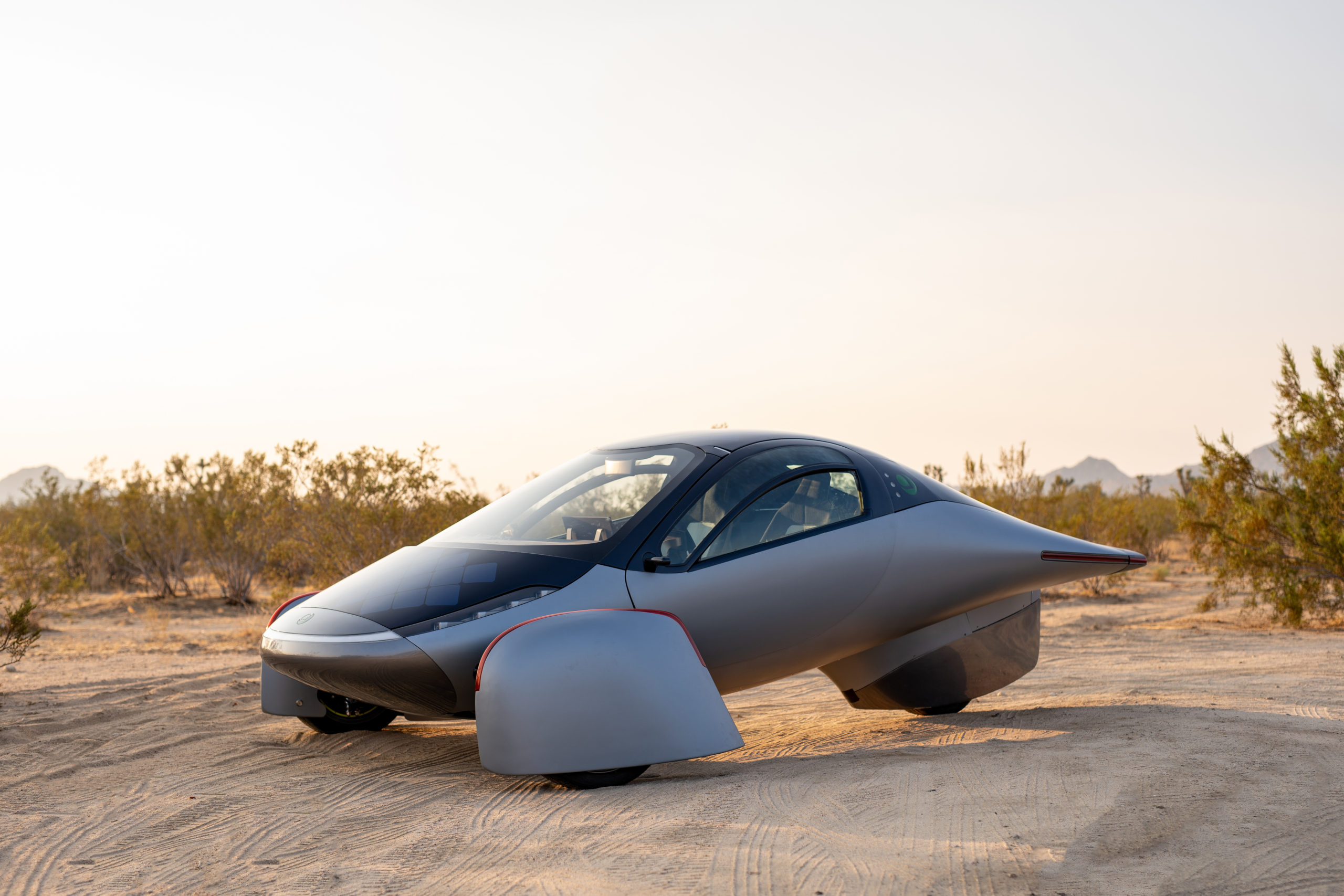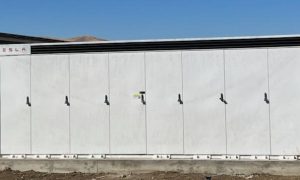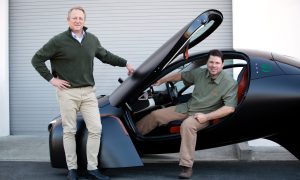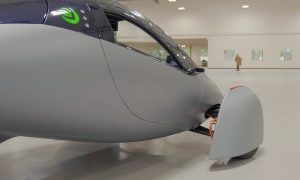I had the fantastic opportunity to talk with Aptera Co-Founder Chris Anthony on Friday. Our short half-hour conversation highlighted production timelines, vehicle design, sustainability, and more.
This weekend, Aptera is participating in the Fully Charged Show, an Electric Vehicle convention in San Diego, where they will be unveiling their Gamma vehicle. According to Co-CEO Chris Anthony, this vehicle is the last stop before attempting to enter production next year. And while the company has a long way before delivering orders, they have over 30,000 reservation holders eagerly awaiting the vehicle’s release.
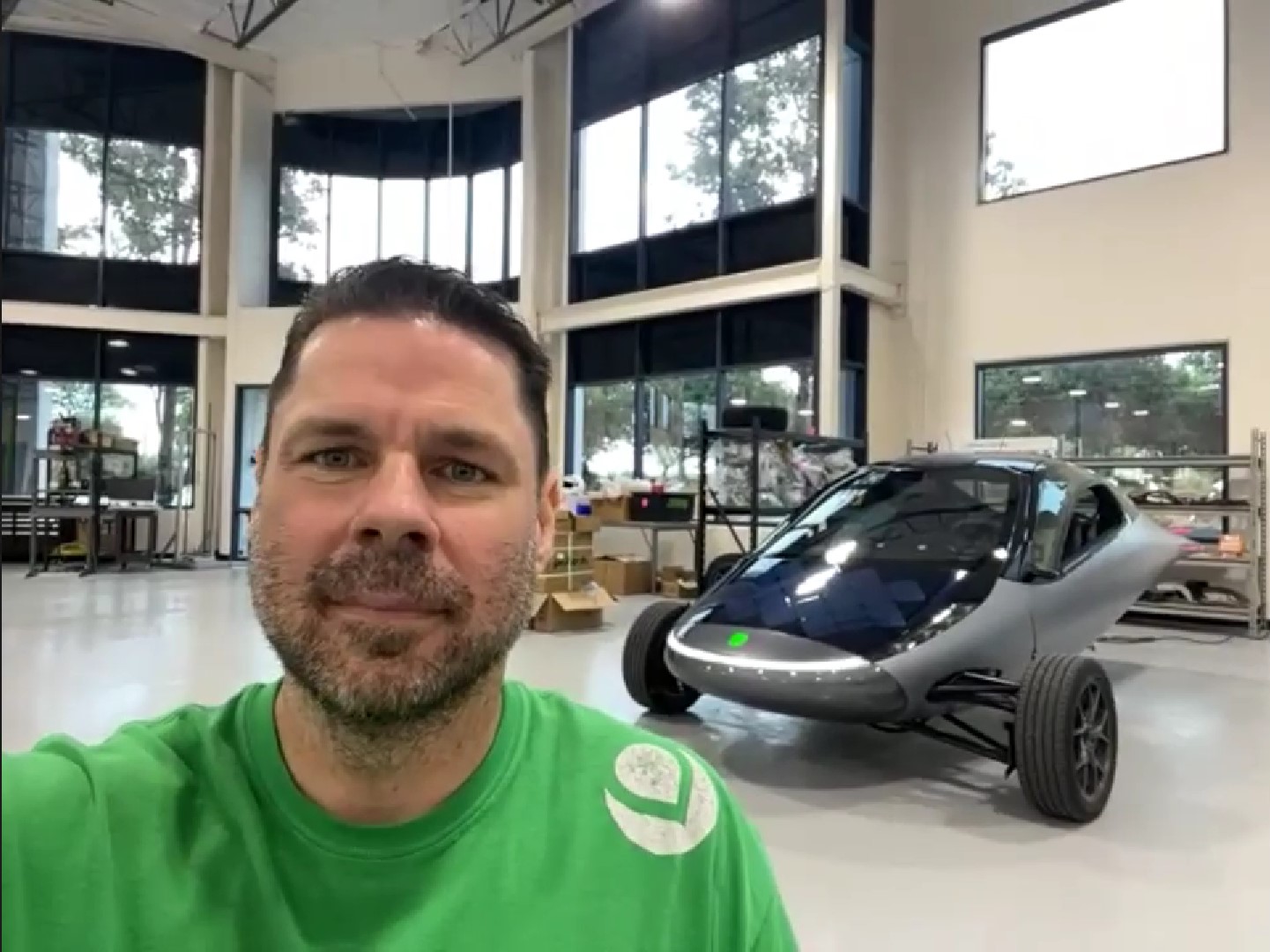
Design language –
The first question I had to ask Mr. Anthony about was the design language of Aptera’s first vehicle. Specifically, what is Aptera attempting to make consumers think and feel when they see the car for the first time?
The first thing that came to the CEO’s mind was capability; he wants consumers to feel like Aptera is just as capable as any other vehicle and can even do more with its unique energy generation capabilities. When he has had the opportunity to have people sit in the vehicle, testers have stated that the vehicle is comfortable, and Mr. Anthony hopes the vehicle’s driving dynamics only further improve the experience.
Capability as a “do everything” vehicle –
Besides the Aptera’s beautiful design, many are looking to buy the Aptera for its function. Coming out of COVID lockdowns, many consumers have been spending more time outside the house, hiking and mountain biking, meeting with friends and family, and taking trips to local events and scenic locations. How has Aptera engineered capability into their vehicle to perform these tasks?
Mr. Anthony points to the car’s solar power generation and the surprising amount of interior space as two critical features in helping people use their vehicles in everyday life. The car’s numerous solar cells mean the vehicle can go further and do more things, which is the ultimate goal of capability. At the same time, the vehicle’s interior is surprisingly spacious, with seven feet of space behind the front seats to the tail; enough room to camp in the vehicle, throw in their mountain bikes, or just travel with their dog.
Customization –
A key part of how many people interact with vehicles today is how they make them their own, customizing the look, feel, and capabilities of the vehicle to best suit their needs. Aptera is not only in support of this goal but is actively working with third-party suppliers to make that dream a reality.
The CEO clarified that Aptera would be more than willing to supply third-party accessory makers with everything from dimensions to CAD files to detailed systems information. He says, “We are happy to share information to help our users find [the vehicle] to be more useful.” As he would note later in the interview, this stems from a “right to repair mindset.”
Possible use of the Tesla Connector –
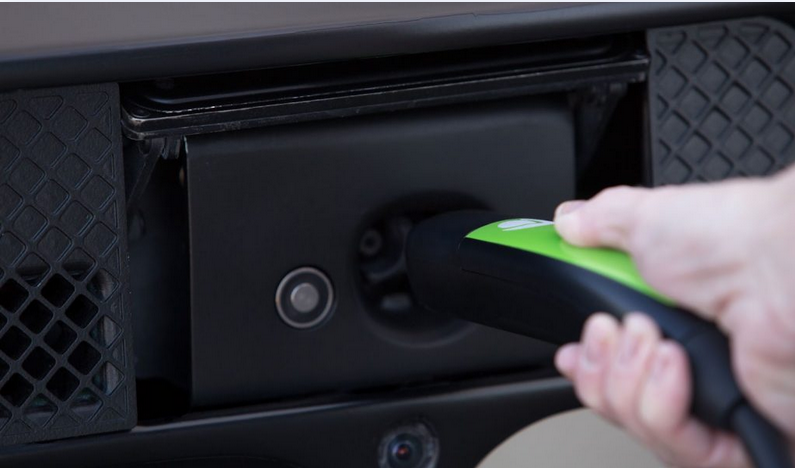
Aptera previously announced that they were not only attempting to include the Tesla connector on their vehicle but also attempting to make the connector the U.S. standard EV connector. However, it remains unclear if Aptera will include the connector in the vehicle, and doubtful that the Tesla Connector would become the US standard.
Nonetheless, Mr. Anthony stood behind the engineering of the Tesla connector. Foremost, he cited the connector’s ease of use and smaller size, which makes it far easier to maneuver than other connector types. But the connector also benefits from supporting the vast majority of electric vehicles in the U.S.
The CEO even went as far as saying that the U.S. should be spending more money supporting Tesla supercharger locations as long as the government plans to expand EV charging anyway.
Aptera’s future goals –
It is clear that Aptera will be focused on getting to production and delivering to their over 30,000 reservation holders in the immediate future. But if the company can achieve these goals, where does the CEO see the company’s next focus?
First, Mr. Anthony doesn’t see the company abandoning the two-door/two-seater form factor. He argues that the Aptera is an ideal complimentary car, helping you complete your daily commute and essential activities that don’t require a lot of space.
Perhaps more excitingly, the CEO did hint at the possibility of multiple variants of the Aptera, a commercial version or a version with more cargo capacity, for instance. No other details are known about these ideas yet.
Production timeline –
With the unveiling of Aptera’s Gamma vehicle this weekend, the company will now be shifting to getting to production as soon as next year. And while the CEO acknowledged that the timeline might not be as fast as some have wanted, he believes in doing the process correctly the first time and hopefully avoiding future issues.
“We have the good graces of our reservation holders to do it right…”
With Aptera’s current production facility in California, they aim to produce 20,000 units within the first year, meaning that filling the 30,000 reservations will take roughly a year and a half. However, any prediction outside of the company is pure conjecture.
Sustainability –
Consumers now more than ever are looking to get the best option for them and the best choice for the planet. Automakers recognize this, and many produce vehicles with sustainable interior parts, recycled metal components, and more. What does the pursuit of sustainability look like for Aptera?
The most sustainable material on Earth is the material not mined, was the conclusion of Mr. Anthony. While others may have been looking to use more sustainable materials, Aptera has pointed itself at using fewer materials in the first place. Aptera achieves this by producing a smaller vehicle, pursuing low curb weight, and reducing the number of interior components.
The pursuit of lightweight sustainability has trickle-down effects as well. Because of the vehicle’s low weight, it requires less energy to move and hence can use fewer batteries to achieve the same range, once again reducing weight (a positive feedback loop).
Ultimately, Mr. Anthony notes that fewer rare earth minerals are mined, and the vehicle as a whole becomes a more sustainable option for consumers. More specifically, Aptera uses 30% of the metal found in a typical vehicle, uses recycled composite materials for its exterior body panels, and uses recycled cloth and plastics on the interior.
The long-term goal is to have these vehicles on the road 50 years from now via upgraded parts along the way; better batteries, improved solar cells, replaceable interior pieces, etc.
Efficiency and beauty –
Manufacturers worldwide have been using aerodynamics to improve efficiency since the car’s inception. But perhaps most recently, due to the limitations of battery capacity, this pursuit has resulted in finding the most efficient shape possible, arguably at the cost of design. While vehicles like the Lucid Air and Mercedes EQS may have been beautiful in previous years, with the introduction of the Volkswagen ID Aero, it is clear that manufacturers are willing to trade unoriginality for efficiency.
Mr. Anthony doesn’t think that this has to be the case. In his response to this issue, he notes that Aptera proves that new and exciting designs can still be made in different form factors while still achieving maximal efficiency.
Are smaller vehicles the future? –
Aptera has highlighted the numerous benefits of producing smaller form factor vehicles. They can be more efficient, reduce manufacturing costs, be more aerodynamic, and be more sustainable. But are these motivators enough to get Americans to buy smaller vehicles in the future?
The CEO doesn’t believe so. Americans are obsessed with huge vehicles, evidenced by exceptionally high SUV and Truck sales. But perhaps, if anything, Aptera can show Americans what future transportation could look like, and if they are willing to give it a chance, maybe it will even change hearts and minds.
Aptera CEO Chris Anthony was incredibly gracious in giving Teslarati a piece of his busy schedule. If you want to learn more about the company’s vehicle, go to their website. And if you happen to be in the San Diego area, it’s worth the trip to the Fully Charged Show to check out the Aptera booth and the numerous other manufacturers attending the event.
William is not an Aptera ambassador, order holder, or investor.
What do you think of the article? Do you have any comments, questions, or concerns? Shoot me an email at william@teslarati.com. You can also reach me on Twitter @WilliamWritin. If you have news tips, email us at tips@teslarati.com!
News
Tesla launches in India with Model Y, showing pricing will be biggest challenge
Tesla finally got its Model Y launched in India, but it will surely come at a price for consumers.

Tesla has officially launched in India following years of delays, as it brought its Model Y to the market for the first time on Tuesday.
However, the launch showed that pricing is going to be its biggest challenge. The all-electric Model Y is priced significantly higher than in other major markets in which Tesla operates.
On Tuesday, Tesla’s Model Y went up for sale for 59,89,000 rupees for the Rear-Wheel Drive configuration, while the Long Range Rear-Wheel Drive was priced at 67,89,000.
This equates to $69,686 for the RWD and $78,994 for the Long Range RWD, a substantial markup compared to what these cars sell for in the United States.
🚨 Here’s the difference in price for the Tesla Model Y in the U.S. compared to India.
🚨 59,89,000 is $69,686
🚨 67,89,000 is $78,994 pic.twitter.com/7EUzyWLcED— TESLARATI (@Teslarati) July 15, 2025
Deliveries are currently scheduled for the third quarter, and it will be interesting to see how many units they can sell in the market at this price point.
The price includes tariffs and additional fees that are applied by the Indian government, which has aimed to work with foreign automakers to come to terms on lower duties that increase vehicle cost.
Tesla Model Y seen testing under wraps in India ahead of launch
There is a chance that these duties will be removed, which would create a more stable and affordable pricing model for Tesla in the future. President Trump and Indian Prime Minister Narendra Modi continue to iron out those details.
Maharashtra Chief Minister Devendra Fadnavis said to reporters outside the company’s new outlet in the region (via Reuters):
“In the future, we wish to see R&D and manufacturing done in India, and I am sure at an appropriate stage, Tesla will think about it.”
It appears to be eerily similar to the same “game of chicken” Tesla played with Indian government officials for the past few years. Tesla has always wanted to enter India, but was unable to do so due to these import duties.
India wanted Tesla to commit to building a Gigafactory in the country, but Tesla wanted to test demand first.
It seems this could be that demand test, and the duties are going to have a significant impact on what demand will actually be.
Elon Musk
Tesla ups Robotaxi fare price to another comical figure with service area expansion
Tesla upped its fare price for a Robotaxi ride from $4.20 to, you guessed it, $6.90.

Tesla has upped its fare price for the Robotaxi platform in Austin for the first time since its launch on June 22. The increase came on the same day that Tesla expanded its Service Area for the Robotaxi ride-hailing service, offering rides to a broader portion of the city.
The price is up from $4.20, a figure that many Tesla fans will find amusing, considering CEO Elon Musk has used that number, as well as ’69,’ as a light-hearted attempt at comedy over the past several years.
Musk confirmed yesterday that Tesla would up the price per ride from that $4.20 point to $6.90. Are we really surprised that is what the company decided on, as the expansion of the Service Area also took effect on Monday?
But the price is now a princely $6.90, as foretold in the prophecy 😂
— Elon Musk (@elonmusk) July 14, 2025
The Service Area expansion was also somewhat of a joke too, especially considering the shape of the new region where the driverless service can travel.
I wrote yesterday about how it might be funny, but in reality, it is more of a message to competitors that Tesla can expand in Austin wherever it wants at any time.
Tesla’s Robotaxi expansion wasn’t a joke, it was a warning to competitors
It was only a matter of time before the Robotaxi platform would subject riders to a higher, flat fee for a ride. This is primarily due to two reasons: the size of the access program is increasing, and, more importantly, the service area is expanding in size.
Tesla has already surpassed Waymo in Austin in terms of its service area, which is roughly five square miles larger. Waymo launched driverless rides to the public back in March, while Tesla’s just became available to a small group in June. Tesla has already expanded it, allowing new members to hail a ride from a driverless Model Y nearly every day.
The Robotaxi app is also becoming more robust as Tesla is adding new features with updates. It has already been updated on two occasions, with the most recent improvements being rolled out yesterday.
Tesla updates Robotaxi app with several big changes, including wider service area
News
Tesla Model Y and Model 3 dominate U.S. EV sales despite headwinds
Tesla’s two mainstream vehicles accounted for more than 40% of all EVs sold in the United States in Q2 2025.

Tesla’s Model Y and Model 3 remained the top-selling electric vehicles in the U.S. during Q2 2025, even as the broader EV market dipped 6.3% year-over-year.
The Model Y logged 86,120 units sold, followed by the Model 3 at 48,803. This means that Tesla’s two mainstream vehicles accounted for 43% of all EVs sold in the United States during the second quarter, as per data from Cox Automotive.
Tesla leads amid tax credit uncertainty and a tough first half
Tesla’s performance in Q2 is notable given a series of hurdles earlier in the year. The company temporarily paused Model Y deliveries in Q1 as it transitioned to the production of the new Model Y, and its retail presence was hit by protests and vandalism tied to political backlash against CEO Elon Musk. The fallout carried into Q2, yet Tesla’s two mass-market vehicles still outsold the next eight EVs combined.
Q2 marked just the third-ever YoY decline in quarterly EV sales, totaling 310,839 units. Electric vehicle sales, however, were still up 4.9% from Q1 and reached a record 607,089 units in the first half of 2025. Analysts also expect a surge in Q3 as buyers rush to qualify for federal EV tax credits before they expire on October 1, Cox Automotive noted in a post.
Legacy rivals gain ground, but Tesla holds its commanding lead
General Motors more than doubled its EV volume in the first half of 2025, selling over 78,000 units and boosting its EV market share to 12.9%. Chevrolet became the second-best-selling EV brand, pushing GM past Ford and Hyundai. Tesla, however, still retained a commanding 44.7% electric vehicle market share despite a 12% drop in in Q2 revenue, following a decline of almost 9% in Q1.
Incentives reached record highs in Q2, averaging 14.8% of transaction prices, roughly $8,500 per vehicle. As government support winds down, the used EV market is also gaining momentum, with over 100,000 used EVs sold in Q2.
Q2 2025 Kelley Blue Book EV Sales Report by Simon Alvarez on Scribd
-

 News3 days ago
News3 days agoTesla debuts hands-free Grok AI with update 2025.26: What you need to know
-

 Elon Musk1 week ago
Elon Musk1 week agoElon Musk confirms Grok 4 launch on July 9 with livestream event
-

 Elon Musk5 days ago
Elon Musk5 days agoxAI launches Grok 4 with new $300/month SuperGrok Heavy subscription
-

 News2 weeks ago
News2 weeks agoTesla Model 3 ranks as the safest new car in Europe for 2025, per Euro NCAP tests
-

 Elon Musk2 weeks ago
Elon Musk2 weeks agoxAI’s Memphis data center receives air permit despite community criticism
-

 News5 days ago
News5 days agoTesla begins Robotaxi certification push in Arizona: report
-

 Elon Musk2 weeks ago
Elon Musk2 weeks agoTesla reveals it is using AI to make factories more sustainable: here’s how
-

 Elon Musk2 weeks ago
Elon Musk2 weeks agoTesla scrambles after Musk sidekick exit, CEO takes over sales

